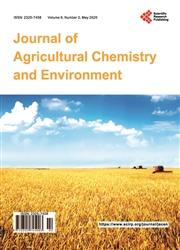Health Risk Assessment of Compost-Amended Soils
引用次数: 0
Abstract
Application of improperly treated compost from composting toilet is one of the causes of bacterial contamination in the field, crops, food and water. The study characterized the die-off represented by kinetic inactivation rate coefficient, k (h-1) of Enterococcus in clay and sandy loam soils, determined the effect of temperature, compost-to-soil ratio and soil type on the inactivation rates of Enterococcus and evaluated the health risk associated with the amendment of compost from composting toilet in real conditions using local climatic data. The soils were amended with compost to soil ratios of 1:10, 1:25, 1:50 and 1:100 held at different temperatures (30°C, 40°C and 50°C). Inactivation of Enterococcus (pathogenic bacteria) in the soil with high temperature under different compost application rates was tried in the laboratory test and the Quantitative Microbial Health Risk evaluated. The study results indicated the inactivation rates of Enterococcus in clay soils as 0.015 - 0.027 h-1, 0.246 - 0.322 h-1, 0.397 - 0.571 h-1 whilst sandy loam soils recorded 0.056 - 0.130 h-1, 0.348 - 0.447 h-1 and 0.475 - 0.630 h-1 for 30°C, 40°C and 50°C respectively. Inactivation rates of Enterococcus in soils amended with compost from the composting toilet depended on temperature and soil type but not on the compost-to-soil ratios and compost from the composting toilet amended to the soils is safe for use in six (6) days.堆肥改良土壤的健康风险评估
堆肥厕所堆肥处理不当是造成农田、作物、食品和水污染的原因之一。本研究表征了肠球菌在粘土和沙壤土中的动态失活速率系数k(h-1)所代表的死亡,确定了温度的影响,堆肥与土壤的比例和土壤类型对肠球菌灭活率的影响,并利用当地气候数据评估了在实际条件下改良堆肥厕所堆肥的健康风险。在不同温度(30°C、40°C和50°C)下,用1:10、1:25、1:50和1:100的堆肥对土壤进行改良。在实验室试验中,尝试在不同堆肥施用率下对高温土壤中的肠球菌(致病菌)进行灭活,并对定量微生物健康风险进行评估。研究结果表明,在30°C、40°C和50°C的条件下,粘土质中肠球菌的灭活率分别为0.015-0.027 h-1、0.246-0.322 h-1、0.397-0.571 h-1,而沙壤土的灭活速率分别为0.056-0.130 h-1、0.308-0.447 h-1和0.475-0.630 h-1。用堆肥厕所堆肥改良的土壤中肠球菌的灭活率取决于温度和土壤类型,但不取决于堆肥与土壤的比例,堆肥厕所改良的堆肥在六(6)天内可以安全使用。
本文章由计算机程序翻译,如有差异,请以英文原文为准。
求助全文
约1分钟内获得全文
求助全文

 求助内容:
求助内容: 应助结果提醒方式:
应助结果提醒方式:


